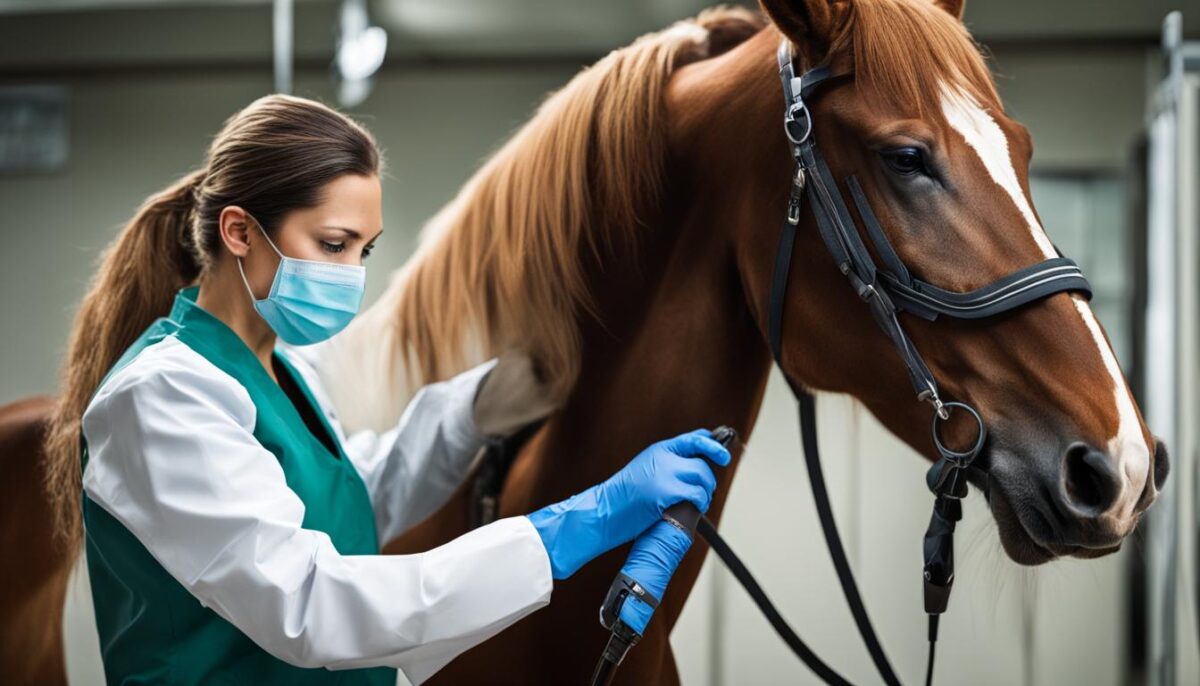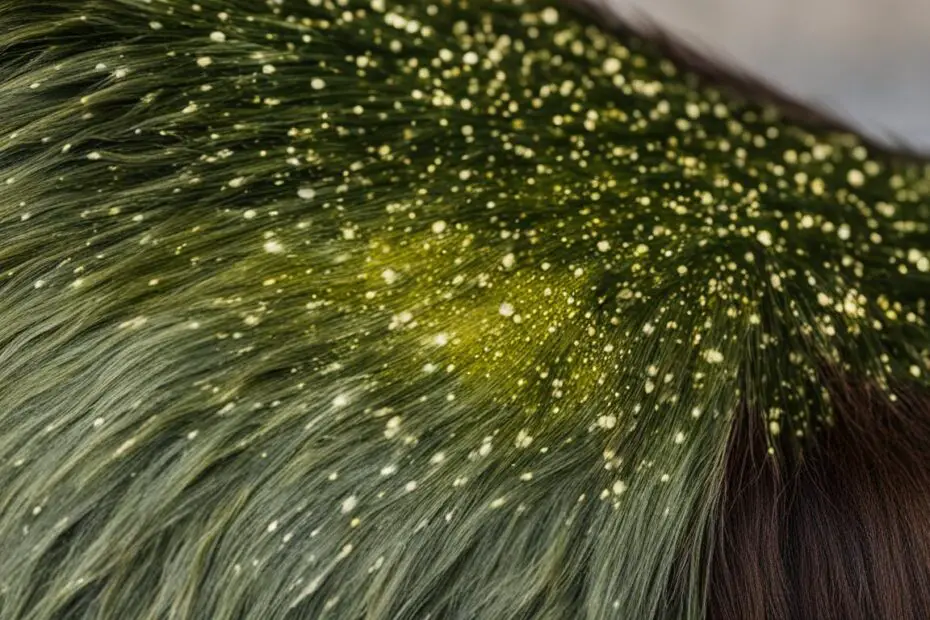Horse sheath yeast infection is a common issue that affects the health and wellness of horses. It is important to understand the causes, symptoms, and effective treatment options to ensure the well-being of your horse. In this section, we will explore the various causes of horse sheath yeast infection, how to diagnose it, and the most effective treatment methods.
Key Takeaways:
- Horse sheath yeast infection is a common problem that requires proper understanding and treatment.
- Causes of horse sheath yeast infection include poor hygiene, improper cleaning techniques, and compromised immune system.
- Diagnosis involves a physical examination and laboratory analysis of symptoms.
- Effective treatment options include topical antifungal ointments, systemic medications, and good hygiene practices.
- Prevention is important through regular cleaning, proper grooming, and maintaining overall horse health.
Understanding Horse Sheath Health
The horse sheath plays a crucial role in a horse’s reproductive and urinary system. Proper care and cleaning of the sheath are essential to prevent the buildup of dirt, debris, and bacteria, which can lead to yeast infections. Regular cleaning and maintenance of the horse’s sheath are important for preventing and managing horse sheath yeast infections.
Equine sheath care involves gentle cleaning and inspection of the sheath area. This process helps remove smegma, a waxy substance that can accumulate in the sheath. Smegma can harbor bacteria and yeast, leading to infection and discomfort for the horse. By regularly cleaning the sheath, horse owners can reduce the risk of yeast infections and ensure the overall health of their horse.
Proper Horse Sheath Cleaning Techniques
- Gather the necessary cleaning supplies, including clean water, mild equine-specific cleanser, clean towels, and gloves.
- Ensure the horse is in a safe and comfortable environment, preferably tied or held by a trusted handler.
- Start by gently rinsing the sheath area with warm water to remove loose debris.
- Dilute the equine cleanser according to the manufacturer’s instructions and apply it to the sheath area.
- Gently massage the cleanser into the skin, paying attention to any visible smegma or buildup.
- Rinse the sheath thoroughly with clean water, ensuring all traces of cleanser are removed.
- Pat the sheath area dry with a clean towel, taking care not to cause any discomfort to the horse.
- Dispose of any used materials properly and wash your hands thoroughly.
Regular sheath cleaning should be included as part of a horse’s grooming routine. However, it is important to note that excessive cleaning or the use of harsh chemicals can disrupt the natural balance of the sheath and potentially lead to irritation or infection. Horse owners should consult with their veterinarian for specific guidance on the frequency and technique of sheath cleaning for their individual horse.
Symptoms of Sheath Yeast Infection
Horse sheath yeast infections can manifest with various symptoms that indicate an issue. Recognizing these symptoms is crucial for early diagnosis and prompt treatment. Common symptoms of a sheath yeast infection in horses include:
- Redness and inflammation in the sheath area
- Swelling and discomfort
- Foul odor
- Abnormal discharge
- Behavioral changes, such as increased irritability or restlessness
It’s important to note that these symptoms can vary in severity, and not all horses will exhibit all of them. Some horses may only show mild redness and discomfort, while others may experience more pronounced swelling and discharge. If you notice any of these symptoms in your horse, it is recommended to consult with a veterinarian for a proper diagnosis.
Proper diagnosis of a sheath yeast infection involves a thorough physical examination of the horse’s sheath area by a veterinarian. In some cases, the veterinarian may also collect samples from the sheath for laboratory analysis to confirm the presence of yeast or other pathogens. It’s important to rely on professional veterinary expertise to accurately diagnose and treat sheath yeast infections, as self-diagnosis can lead to ineffective or inappropriate treatment.
By recognizing the symptoms of sheath yeast infection and seeking timely veterinary care, horse owners can ensure the well-being and overall wellness of their horses. Prompt diagnosis and treatment are key to managing the infection and preventing potential complications.

Treatment Options for Sheath Yeast Infection
Once a sheath yeast infection has been diagnosed, there are several treatment options available to effectively address the infection and promote healing. Treatment approaches may include:
- Topical antifungal ointments or creams: These can be applied directly to the affected area to combat the overgrowth of yeast.
- Antifungal shampoos: Regular cleansing of the sheath area with medicated shampoos can help eliminate yeast and maintain hygiene.
- Systemic antifungal medications: In severe or persistent cases, oral or injectable antifungal medications may be prescribed by a veterinarian.
- Improved sheath hygiene: Proper cleaning techniques and regular maintenance of sheath hygiene can prevent reinfection and support the effectiveness of treatment.
It’s essential to follow the treatment plan recommended by the veterinarian to ensure successful resolution of the sheath yeast infection. Strict adherence to the prescribed medication and hygiene practices is crucial for a complete recovery.
Causes of Horse Sheath Yeast Infection
Preventing yeast infections in horse sheaths is crucial for maintaining equine health care. By understanding the causes of these infections, horse owners can take preventive measures to minimize the risk. Several factors contribute to the development of horse sheath yeast infections, including poor hygiene, improper cleaning techniques, excessive moisture, and a compromised immune system.
Poor hygiene is one of the leading causes of yeast infections in horse sheaths. Failure to regularly clean the sheath can lead to a buildup of dirt, debris, and bacteria, creating an ideal environment for yeast to thrive. Additionally, improper cleaning techniques, such as using harsh chemicals or rough tools, can irritate the delicate tissues in the sheath and disrupt the natural balance, making the horse more susceptible to infections.
Excessive moisture in the sheath area can also contribute to yeast infections. Prolonged exposure to wet conditions or inadequate drying after cleaning can create a damp environment that promotes the growth of yeast-causing organisms. It is important to ensure proper drying of the sheath area to prevent the development of infections.
Furthermore, a compromised immune system can increase the horse’s vulnerability to sheath yeast infections. Factors such as age, underlying health conditions, stress, and a poor diet can weaken the immune system, making the horse more susceptible to infections. Maintaining a healthy lifestyle, providing a balanced diet, and minimizing stress can help strengthen the horse’s immune system and reduce the risk of yeast infections.
Table: Comparative Analysis of Causes
| Cause | Description |
|---|---|
| Poor Hygiene | Failure to clean the sheath regularly and using improper cleaning techniques |
| Excessive Moisture | Prolonged exposure to wet conditions or inadequate drying after cleaning |
| Compromised Immune System | Weakened immune system due to age, underlying health conditions, stress, or poor diet |
Inadequate hygiene practices and improper cleaning techniques can create an environment conducive to yeast growth in a horse’s sheath. Additionally, excessive moisture and a compromised immune system can further increase the risk of infections. It is crucial for horse owners to prioritize preventive measures to minimize the occurrence of sheath yeast infections and maintain equine health care.
Diagnosing Horse Sheath Yeast Infection
Determining if a horse has a sheath yeast infection involves a combination of physical examination, symptom evaluation, and laboratory analysis. Veterinary professionals are skilled in diagnosing and treating equine health issues, including sheath infections. During a physical examination, the veterinarian will assess the horse’s sheath for any signs of redness, swelling, or discharge. These symptoms can indicate the presence of a yeast infection.
Based on the physical examination findings, the veterinarian may recommend collecting samples from the horse’s sheath for laboratory analysis. This can involve swabbing the affected area and sending the sample to a laboratory for testing. The laboratory analysis helps confirm the presence of yeast and aids in formulating an appropriate treatment plan.
It’s important to consult with a veterinarian for an accurate diagnosis as other conditions, such as bacterial infections or allergic reactions, can present similar symptoms. By relying on their expertise, horse owners can ensure proper diagnosis and effective treatment of sheath yeast infections, promoting the horse’s health and wellness.
Table: Diagnostic Methods for Horse Sheath Yeast Infection
| Diagnostic Method | Description |
|---|---|
| Physical examination | Assessing the sheath for redness, swelling, discharge, and discomfort. |
| Laboratory analysis | Collecting samples for laboratory testing to confirm the presence of yeast and aid in treatment planning. |
| Microscopic examination | Examining sheath samples under a microscope to identify yeast cells. |
| Culture testing | Growing yeast from sheath samples to further confirm the diagnosis and assess the sensitivity to different antifungal medications. |
Through a combination of physical examination, laboratory analysis, and other diagnostic techniques, veterinary professionals can accurately diagnose horse sheath yeast infections. This allows for targeted treatment and improved horse wellness.

Effective Treatment Options for Horse Sheath Yeast Infection
When it comes to treating horse sheath yeast infections, a combination of approaches is often necessary to ensure effective results. The treatment plan will depend on the severity of the infection and the recommendations of your veterinarian. Here are some of the most common and effective treatment options:
1. Topical Antifungal Ointments or Shampoos
Topical antifungal products can be applied directly to the affected area to help eliminate the yeast infection. These ointments or shampoos typically contain active ingredients that target and destroy the yeast. It’s important to follow the instructions provided by your veterinarian and apply the product as directed to achieve optimal results.
2. Systemic Antifungal Medications
In severe cases or when topical treatments alone are not sufficient, your veterinarian may prescribe systemic antifungal medications. These medications are administered orally and work by targeting the yeast throughout the horse’s body. It’s crucial to follow the prescribed dosage and duration of treatment to ensure the complete resolution of the infection.
3. Maintaining Good Hygiene Practices
In addition to medication, it’s important to maintain good hygiene practices to prevent the recurrence of yeast infections. Regular cleaning of the sheath and surrounding areas can help remove dirt, debris, and excess moisture that may contribute to the growth of yeast. Use gentle cleansers specifically designed for equine use and avoid using harsh chemicals that can irritate the skin.
4. Veterinary Guidance
It is essential to seek veterinary advice for the diagnosis and treatment of horse sheath yeast infections. Your veterinarian will be able to provide personalized recommendations based on the specific needs of your horse. They can also monitor the progress of the treatment and make any necessary adjustments to ensure the best outcome for your horse’s health and wellness.
By following a comprehensive treatment plan that includes the appropriate medications, good hygiene practices, and veterinary guidance, horse owners can effectively treat and manage horse sheath yeast infections. It’s important to be patient and consistent in the treatment process to achieve the desired results and maintain the overall health and well-being of your horse.
Preventing Horse Sheath Yeast Infections
Preventing horse sheath yeast infections is essential for maintaining the health and well-being of your horse. By following proper grooming tips and equine health care practices, you can minimize the risk of yeast infections in your horse’s sheath.
Regular Cleaning and Hygiene Practices
Regular cleaning of the horse’s sheath is crucial for preventing yeast infections. Use gentle cleansers and avoid harsh chemicals that can disrupt the natural balance of the sheath. It’s important to remove dirt, debris, and bacteria that can contribute to the growth of yeast-causing organisms.
When cleaning the sheath, take care to use clean tools and gentle techniques. Avoid excessive force or rough handling, as this can cause irritation and create an environment conducive to infection. Regularly inspect the sheath for any signs of redness, swelling, or discharge, which may indicate an infection.
Proper Diet and Overall Horse Health
An important aspect of preventing horse sheath yeast infections is maintaining a healthy diet and overall horse health. A well-balanced diet rich in essential nutrients can help strengthen the horse’s immune system, making it more resistant to infections.
In addition to a healthy diet, provide your horse with regular exercise to promote circulation and strengthen its overall well-being. Ensuring proper hydration and maintaining a clean and comfortable environment for your horse can also contribute to its overall health and reduce the risk of infections.
Veterinary Guidance
Regular veterinary check-ups and guidance are crucial in preventing and managing horse sheath yeast infections. Your veterinarian can provide specific recommendations based on your horse’s individual needs and help detect any early signs of infection.
Follow your veterinarian’s advice for preventive measures, such as vaccination and deworming protocols, to maintain your horse’s optimal health. If you notice any changes in your horse’s behavior or signs of discomfort, seek veterinary attention promptly for proper diagnosis and treatment.
| Preventive Measures | Description |
|---|---|
| Regular Sheath Cleaning | Use gentle cleansers and avoid harsh chemicals that can disrupt the natural balance of the sheath. |
| Proper Nutrition | A well-balanced diet rich in essential nutrients can strengthen the horse’s immune system. |
| Regular Exercise | Exercise promotes circulation and overall horse well-being, reducing the risk of infections. |
| Veterinary Guidance | Regular check-ups and guidance from a veterinarian are essential in preventing and managing infections. |
By implementing these preventive measures and maintaining a proactive approach to equine health care, you can minimize the risk of horse sheath yeast infections and ensure the well-being of your horse.

Importance of Horse Grooming in Sheath Health
Grooming plays a crucial role in maintaining the overall health and well-being of horses, and this certainly applies to the health of their sheaths as well. Regular grooming not only helps to keep the horse’s coat clean and shiny but also prevents the buildup of dirt, debris, and bacteria in the sheath area. By incorporating effective grooming practices into your horse care routine, you can promote optimal sheath health and minimize the risk of yeast infections.
When it comes to grooming the sheath area, it is important to use gentle techniques and clean tools. Harsh brushing or scrubbing can cause irritation and discomfort to the horse. Instead, opt for soft brushes and mild cleansers specifically designed for equine use. Take care to remove any dirt, smegma, or buildup that may be present in the sheath folds, paying attention to areas such as the urethral opening and the bean.
In addition to regular cleaning, it is crucial to maintain good overall hygiene practices for your horse. This includes keeping their living environment clean, regularly changing bedding, and ensuring proper manure management. Hygiene is essential in preventing the accumulation of bacteria and yeast-causing organisms that can lead to sheath infections.
The Benefits of Regular Sheath Grooming
- Prevents the buildup of dirt, debris, and bacteria in the sheath area.
- Reduces the risk of sheath yeast infections.
- Promotes optimal sheath health and overall horse wellness.
- Allows for early detection of any abnormalities or issues.
- Creates a bond and trust between you and your horse.
“Regular grooming not only helps to keep the horse’s coat clean and shiny but also prevents the buildup of dirt, debris, and bacteria in the sheath area.”
Remember, proper grooming and hygiene practices are essential in maintaining the health and well-being of your horse. By taking the time to regularly groom and clean your horse’s sheath, you can contribute to their overall comfort, prevent infections, and ensure they remain in optimal health.

Maintaining Equine Health and Wellness
Horse grooming is a vital aspect of equine health care and plays a significant role in ensuring the overall wellness of horses. Regular grooming routines not only help horses look their best but also promote cleanliness and prevent the development of various infections, including sheath yeast infections. By following proper grooming techniques and implementing effective horse grooming tips, horse owners can contribute to the maintenance of their horse’s health and well-being.
Benefits of Regular Grooming
Regular grooming sessions provide numerous benefits for horses. It helps to remove dirt, sweat, and dead skin cells that can accumulate on the horse’s coat. Regular brushing also improves blood circulation and distributes the natural oils on the horse’s skin, resulting in a healthier and shinier coat. Additionally, grooming allows horse owners to closely examine their horse’s body for any signs of injury, skin problems, or changes in overall health.
Grooming sessions also provide an opportunity for bonding between the horse and the owner. Horses enjoy the attention and physical contact that comes with grooming, which helps build trust and strengthen the human-animal relationship. Furthermore, regular grooming promotes relaxation and comfort for the horse, reducing stress and anxiety.
Key Horse Grooming Tips
When it comes to horse grooming, there are several essential tips to keep in mind:
- Begin with a thorough cleaning of the horse’s coat using a soft brush or curry comb to remove dirt and loose hair.
- Pay special attention to sensitive areas such as the sheath, where debris and bacteria can accumulate. Regular cleaning of the sheath helps prevent yeast infections and discomfort for the horse.
- Use gentle, horse-specific grooming products to avoid skin irritation and maintain a healthy pH balance.
- Trim the horse’s mane, tail, and hooves regularly to prevent tangling, splitting, and overgrowth.
- Check the horse’s hooves daily for any signs of infection or injury. Clean and pick out the hooves to prevent the buildup of dirt and debris.
- Provide regular baths to keep the horse’s coat clean and free from skin infections. Use mild equine shampoo and rinse thoroughly to avoid residue.
- Always approach grooming with a calm and patient attitude, ensuring the horse is comfortable and relaxed throughout the process.
Incorporating Grooming into a Holistic Equine Care Routine
Grooming should be seen as an integral part of a holistic equine care routine that encompasses all aspects of the horse’s health and wellness. In addition to regular grooming, it is important to provide a balanced diet, adequate exercise, and regular veterinary care for optimal horse well-being. By maintaining a clean and healthy environment, addressing any health issues promptly, and ensuring the horse’s physical and emotional needs are met, horse owners can contribute to the overall health and longevity of their equine companions.

Conclusion
Horse sheath yeast infections can be effectively treated and managed with the proper knowledge and care. By understanding the causes, symptoms, and treatment options, horse owners can take proactive steps to prevent and address yeast infections in their horse’s sheath. Regular grooming, good hygiene practices, and veterinary guidance are essential in maintaining the health and well-being of horses.
Proper equine sheath care is crucial for preventing yeast infections. Regular cleaning and maintenance of the horse’s sheath can help remove dirt, debris, and bacteria that can contribute to the development of infections. By incorporating gentle cleansing techniques and avoiding harsh chemicals, horse owners can promote a healthy sheath environment.
Equine yeast infection treatment options include the use of topical antifungal ointments or shampoos, systemic medications, and maintaining good hygiene practices. It is important to follow the treatment plan recommended by a veterinarian to ensure the complete resolution of the infection.
In conclusion, by prioritizing equine sheath care, horse owners can minimize the risk of horse sheath yeast infections. By maintaining good hygiene practices, regular grooming, and seeking veterinary guidance, horse owners can promote the health and well-being of their horses.
FAQ
What are the symptoms of horse sheath yeast infection?
Symptoms of horse sheath yeast infection may include redness, swelling, discomfort, foul odor, discharge, and behavioral changes in the horse.
What causes horse sheath yeast infection?
Horse sheath yeast infection can be caused by poor hygiene, improper cleaning techniques, excessive moisture, and a compromised immune system.
How is horse sheath yeast infection diagnosed?
Horse sheath yeast infection is typically diagnosed through a physical examination and evaluation of symptoms. Veterinarians may also collect samples for laboratory analysis to confirm the presence of yeast.
What are the effective treatment options for horse sheath yeast infection?
Treatment options for horse sheath yeast infection may include topical antifungal ointments or shampoos, systemic antifungal medications, and maintaining good hygiene practices.
How can horse sheath yeast infections be prevented?
Horse sheath yeast infections can be prevented by regular cleaning and proper hygiene practices, including the use of gentle cleansers and avoiding harsh chemicals. Maintaining a proper diet, exercise, and overall health of the horse can also reduce the risk of infections.
Why is horse grooming important for sheath health?
Regular grooming, including cleaning the sheath, is important for overall horse health and well-being. Grooming helps to remove dirt, debris, and bacteria that can contribute to yeast infections and other issues.
How can equine health and wellness be maintained?
Equine health and wellness can be maintained through proper nutrition, exercise, regular veterinary care, and maintaining a clean environment. Taking a holistic approach to equine health care can minimize the risk of various infections, including sheath yeast infections.


